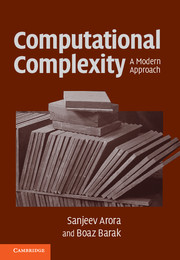Book contents
- Frontmatter
- Contents
- About this book
- Acknowledgments
- Introduction
- 0 Notational conventions
- PART ONE BASIC COMPLEXITY CLASSES
- PART TWO LOWER BOUNDS FOR CONCRETE COMPUTATIONAL MODELS
- 12 Decision trees
- 13 Communication complexity
- 14 Circuit lower bounds: Complexity theory's Waterloo
- 15 Proof complexity
- 16 Algebraic computation models
- PART THREE ADVANCED TOPICS
- Appendix: Mathematical background
- Hints and selected exercises
- Main theorems and definitions
- Bibliography
- Index
- Complexity class index
16 - Algebraic computation models
from PART TWO - LOWER BOUNDS FOR CONCRETE COMPUTATIONAL MODELS
Published online by Cambridge University Press: 05 June 2012
- Frontmatter
- Contents
- About this book
- Acknowledgments
- Introduction
- 0 Notational conventions
- PART ONE BASIC COMPLEXITY CLASSES
- PART TWO LOWER BOUNDS FOR CONCRETE COMPUTATIONAL MODELS
- 12 Decision trees
- 13 Communication complexity
- 14 Circuit lower bounds: Complexity theory's Waterloo
- 15 Proof complexity
- 16 Algebraic computation models
- PART THREE ADVANCED TOPICS
- Appendix: Mathematical background
- Hints and selected exercises
- Main theorems and definitions
- Bibliography
- Index
- Complexity class index
Summary
Is Horner's rule optimal for the evaluation of a polynomial?
–Ostrowski (1954)The Turing machine model captures computations on bits (equivalently, integers), but many natural and useful algorithms are most naturally described as operating on uncountable sets such as the real numbers ℝ or complex numbers ℂ. A simple example is Newton's method for finding roots of a given real-valued function f. It iteratively produces a sequence of candidate solutions x0, x1, x2, …, ∈ ℝ where xi+1 = xi−f (xi)/f′ (xi). Under appropriate conditions this sequence can be shown to converge to a root of f. Likewise, a wide variety of algorithms in numerical analysis, signal processing, computational geometry, robotics, and symbolic algebra typically assume that a basic computational step involves an operation (+, ×, /) in some arbitrary field F. Such algorithms are studied in a field called computer algebra [vzGG99].
One could defensibly argue that allowing arbitrary field operations in an algorithm is unrealistic (at least for fields such as ℝ) since real-life computers can only do arithmetic using finite precision. Indeed, in practice, algorithms like Newton's method have to be carefully implemented within the constraints imposed by finite precision arithmetic. In this chapter though, we take a different approach and study models which do allow arithmetic operations on real numbers (or numbers from fields other than ℝ). Such an idealized model may not be directly implementable but it provides a useful approximation to the asymptotic behavior as computers are allowed to use more and more precision in their computations.
- Type
- Chapter
- Information
- Computational ComplexityA Modern Approach, pp. 318 - 338Publisher: Cambridge University PressPrint publication year: 2009



